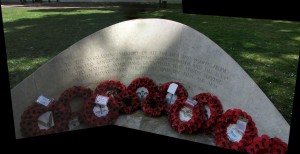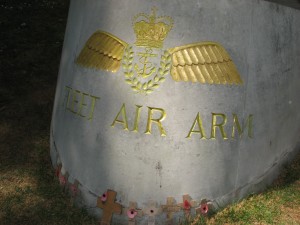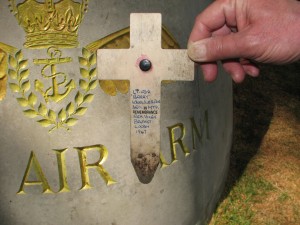 In the Victoria Embankment Gardens along the river Thames in London is a memorial to the Fleet Air Arm of the Royal Navy. The memorial is a striking bronze figure of Daedalus, the ingenious craftsman of Greek legend who created wings to escape King Minos of Crete, only to lose his son Icarus when he flew too close to the sun and his wings melted. Icarus plunged into the sea…
In the Victoria Embankment Gardens along the river Thames in London is a memorial to the Fleet Air Arm of the Royal Navy. The memorial is a striking bronze figure of Daedalus, the ingenious craftsman of Greek legend who created wings to escape King Minos of Crete, only to lose his son Icarus when he flew too close to the sun and his wings melted. Icarus plunged into the sea…
The memorial was designed by Royal Academy artist and sculptor James Butler as a tribute to the more than 6,000 individuals who have given their lives in Royal Navy Air Service since World War I – 1,925 of whom have no graves except the oceans of the world.
Butler’s own words best describe the power of the statue: “I wanted Daedalus to appear mighty, strong and capable, a man and yet half machine, with wings which are an integral part of him and yet still clearly man-made and fastened crudely to his arms. He must have an air of tragedy in his countenance, after all he is mourning the death of his colleagues. With his arms outspread in this position and his head slightly bowed, there are suggestions of crucifixion which signal the sacrifice of the brave men and women in their Naval Service over the years.”
When I saw the statue a few weeks ago on a visit to London with my wife, I noticed some very small, individual tributes left at the base. One was a small wooden cross in memory of “Lt. Commander ‘Barry’ Knowles, RN”. I did some research on Commander Knowles on my return to the United States. David Barry Knowles and his crew mate Ian E. Shaw were lost in the crash of a Sea Vixen aircraft in the Irish Sea on December 4, 1967. The Sea Vixen was a beautiful but exceptionally unforgiving aircraft operated by the Royal Navy off their aircraft carriers for over a decade. Almost 60 Royal Navy aviators lost their lives flying the Sea Vixen.
The Fleet Air Arm Memorial is a truly moving and powerful symbol of the sacrifices of David Barry Knowles, Ian Shaw, and the thousands of others who gave so very much in the service of their country…




Melanie Knowles said:
I find it hard to express how I feel having seen your wonderful description and picture. David Barry Knowles was my father and I have always wondered if there was a memorial to him somewhere as we have no family gravestone or memorial (I am now 45 and he died when I was 1 year old). His disappearance was shrouded in mystery and I grew up never being able to visit a grave or see any real sign of him. I cannot tell you how grateful I am. I live nearby in Brighton and will definitely visit the grave with my husband and children. The only mystery now is who would have left the individual tribute as I didn’t know that anybody in my family knew of this memorial or ever visited it. Do you know if the tribute will still be there, I am not sure how these things work?
With heartfelt gratitude, Melanie .
Doug Wyatt said:
Melanie,
During the period 1962-64 when your father was stationed at Yeovilton,I flew with him in the Admirals aircraft as Aircrewman, we had many good trips and many flying hours together and, as much as a Lt.Commander and a non-commissioned Chief Petty Officer can do, we became good friends.
I was on the Committee that erected the Memorial
in Embankment Gardens and visit it every year and I left the cross there. I have also visited his enscription on the memory wall at the Armed Services Memorial at Alweras.
I can only say he was a very good and brave man, as so many FAA aircrew were you can be very proud of him.
DBW.
Sarah Jones said:
Hi Melanie,
My father was the General Manager of the aircraft repair facility in Ireland at the time – we had moved there for two years from England; one of his many RN postings. I was 2 in 1967. My understanding is my Dad managed the operations to try to find your father, and Lt Shaw. I have his version of what happened that day and would be willing to share with you. Contact me at iamsarah484@gmail.com if you’d like.
Sarah